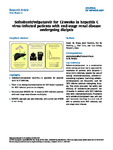Sofosbuvir/velpatasvir for 12 weeks in hepatitis C virus-infected patients with end-stage renal disease undergoing dialysis
| dc.contributor.author | Borgia, SM | |
| dc.contributor.author | Dearden, J | |
| dc.contributor.author | Yoshida, EM | |
| dc.contributor.author | Shafran, SD | |
| dc.contributor.author | Brown, A | |
| dc.contributor.author | Ben-Ari, Z | |
| dc.contributor.author | Cramp, Matthew | |
| dc.contributor.author | Cooper, C | |
| dc.contributor.author | Foxton, M | |
| dc.contributor.author | Rodriguez, CF | |
| dc.contributor.author | Esteban, R | |
| dc.contributor.author | Hyland, R | |
| dc.contributor.author | Lu, S | |
| dc.contributor.author | Kirby, BJ | |
| dc.contributor.author | Meng, A | |
| dc.contributor.author | Markova, S | |
| dc.contributor.author | Dvory-Sobol, H | |
| dc.contributor.author | Osinusi, AO | |
| dc.contributor.author | Bruck, R | |
| dc.contributor.author | Ampuero, J | |
| dc.contributor.author | Ryder, SD | |
| dc.contributor.author | Agarwal, K | |
| dc.contributor.author | Fox, R | |
| dc.contributor.author | Shaw, D | |
| dc.contributor.author | Haider, S | |
| dc.contributor.author | Willems, B | |
| dc.contributor.author | Lurie, Y | |
| dc.contributor.author | Calleja, JL | |
| dc.contributor.author | Gane, EJ | |
| dc.date.accessioned | 2021-10-14T12:58:22Z | |
| dc.date.issued | 2019-10 | |
| dc.identifier.issn | 0168-8278 | |
| dc.identifier.issn | 1600-0641 | |
| dc.identifier.uri | http://hdl.handle.net/10026.1/18068 | |
| dc.description.abstract |
BACKGROUND & AIMS: Although off-label use of sofosbuvir-containing regimens occurs regularly in patients with hepatitis C virus (HCV) infection undergoing dialysis for severe renal impairment or end-stage renal disease (ESRD), these regimens are not licensed for this indication, and there is an absence of dosing recommendations in this population. This study evaluated the safety and efficacy of sofosbuvir/velpatasvir in patients with HCV infection with ESRD undergoing dialysis. METHODS: In this phase II, single-arm study, 59 patients with genotype 1-6 HCV infection with ESRD undergoing hemodialysis or peritoneal dialysis received open-label sofosbuvir/velpatasvir (400 mg/100 mg) once daily for 12 weeks. Patients were HCV treatment naive or treatment experienced without cirrhosis or with compensated cirrhosis. Patients previously treated with any HCV NS5A inhibitor were not eligible. The primary efficacy endpoint was the proportion of patients achieving sustained virologic response (SVR) 12 weeks after discontinuation of treatment (SVR12). The primary safety endpoint was the proportion of patients who discontinued study drug due to adverse events. RESULTS: Overall, 56 of 59 patients achieved SVR12 (95%; 95% CI 86-99%). Of the 3 patients who did not achieve SVR12, 2 patients had virologic relapse determined at post-treatment Week 4 (including 1 who prematurely discontinued study treatment), and 1 patient died from suicide after achieving SVR through post-treatment Week 4. The most common adverse events were headache (17%), fatigue (14%), nausea (14%), and vomiting (14%). Serious adverse events were reported for 11 patients (19%), and all were deemed to be unrelated to sofosbuvir/velpatasvir. CONCLUSIONS: Treatment with sofosbuvir/velpatasvir for 12 weeks was safe and effective in patients with ESRD undergoing dialysis. LAY SUMMARY: Sofosbuvir/velpatasvir is a combination direct-acting antiviral that is approved for treatment of patients with hepatitis C virus (HCV) infection. Despite the lack of dosing recommendations, sofosbuvir-containing regimens (including sofosbuvir/velpatasvir) are frequently used for HCV-infected patients undergoing dialysis. This study evaluated the safety and efficacy of sofosbuvir/velpatasvir for 12 weeks in patients with HCV infection who were undergoing dialysis. Treatment with sofosbuvir/velpatasvir was safe and well tolerated, resulting in a cure rate of 95% in patients with HCV infection and end-stage renal disease. Clinical Trial Number: NCT03036852. | |
| dc.format.extent | 660-665 | |
| dc.format.medium | Print-Electronic | |
| dc.language | en | |
| dc.language.iso | en | |
| dc.publisher | Elsevier | |
| dc.subject | Direct-acting antiviral | |
| dc.subject | ESRD | |
| dc.subject | Severe renal impairment | |
| dc.subject | Chronic hepatitis C infection | |
| dc.subject | HCV | |
| dc.subject | SVR12 | |
| dc.subject | drug safety | |
| dc.title | Sofosbuvir/velpatasvir for 12 weeks in hepatitis C virus-infected patients with end-stage renal disease undergoing dialysis | |
| dc.type | journal-article | |
| dc.type | Clinical Trial | |
| dc.type | Clinical Trial, Phase II | |
| dc.type | Journal Article | |
| dc.type | Multicenter Study | |
| dc.type | Research Support, Non-U.S. Gov't | |
| plymouth.author-url | https://www.webofscience.com/api/gateway?GWVersion=2&SrcApp=PARTNER_APP&SrcAuth=LinksAMR&KeyUT=WOS:000488196300007&DestLinkType=FullRecord&DestApp=ALL_WOS&UsrCustomerID=11bb513d99f797142bcfeffcc58ea008 | |
| plymouth.issue | 4 | |
| plymouth.volume | 71 | |
| plymouth.publication-status | Published | |
| plymouth.journal | Journal of Hepatology | |
| dc.identifier.doi | 10.1016/j.jhep.2019.05.028 | |
| plymouth.organisational-group | /Plymouth | |
| plymouth.organisational-group | /Plymouth/Faculty of Health | |
| plymouth.organisational-group | /Plymouth/Faculty of Health/Peninsula Medical School | |
| plymouth.organisational-group | /Plymouth/REF 2021 Researchers by UoA | |
| plymouth.organisational-group | /Plymouth/REF 2021 Researchers by UoA/UoA01 Clinical Medicine | |
| plymouth.organisational-group | /Plymouth/Research Groups | |
| plymouth.organisational-group | /Plymouth/Research Groups/Institute of Translational and Stratified Medicine (ITSMED) | |
| plymouth.organisational-group | /Plymouth/Research Groups/Institute of Translational and Stratified Medicine (ITSMED)/CBR | |
| plymouth.organisational-group | /Plymouth/Users by role | |
| plymouth.organisational-group | /Plymouth/Users by role/Academics | |
| dc.publisher.place | Netherlands | |
| dcterms.dateAccepted | 2019-05-29 | |
| dc.rights.embargodate | 2021-12-8 | |
| dc.identifier.eissn | 1600-0641 | |
| dc.rights.embargoperiod | Not known | |
| rioxxterms.versionofrecord | 10.1016/j.jhep.2019.05.028 | |
| rioxxterms.licenseref.uri | http://www.rioxx.net/licenses/all-rights-reserved | |
| rioxxterms.licenseref.startdate | 2019-10 | |
| rioxxterms.type | Journal Article/Review |


